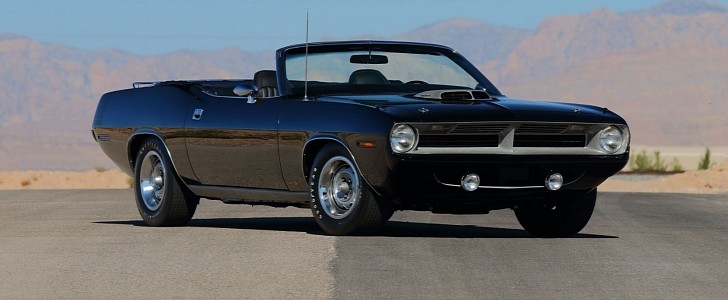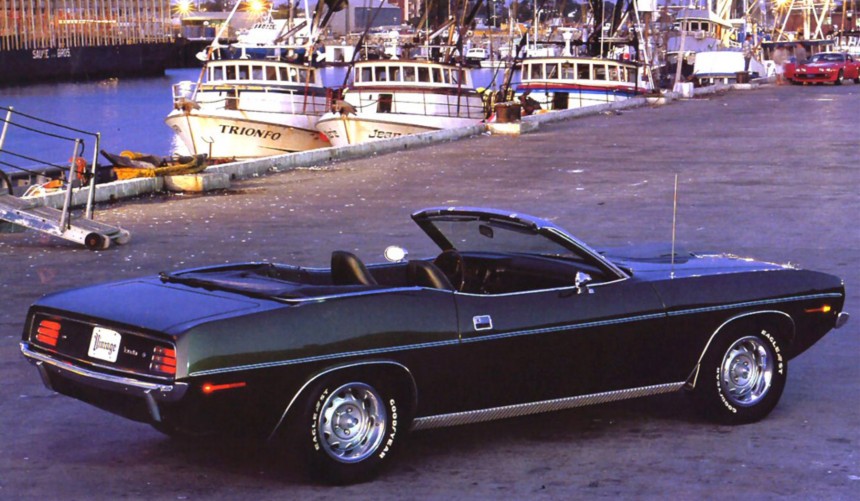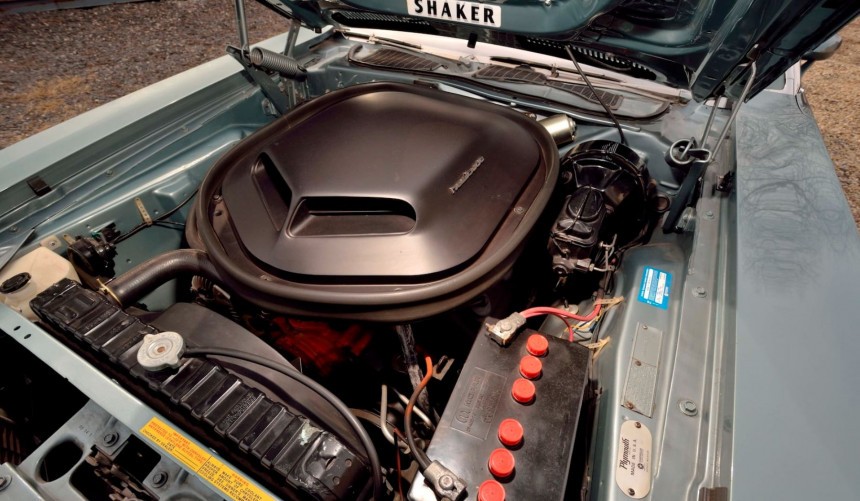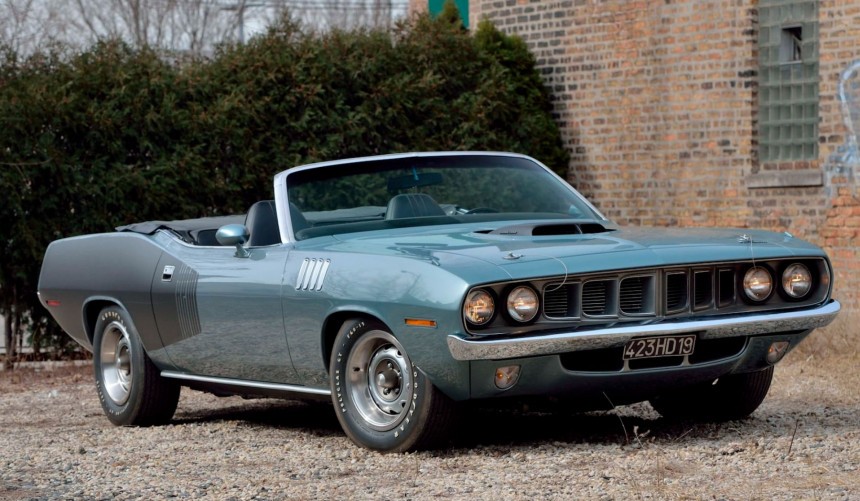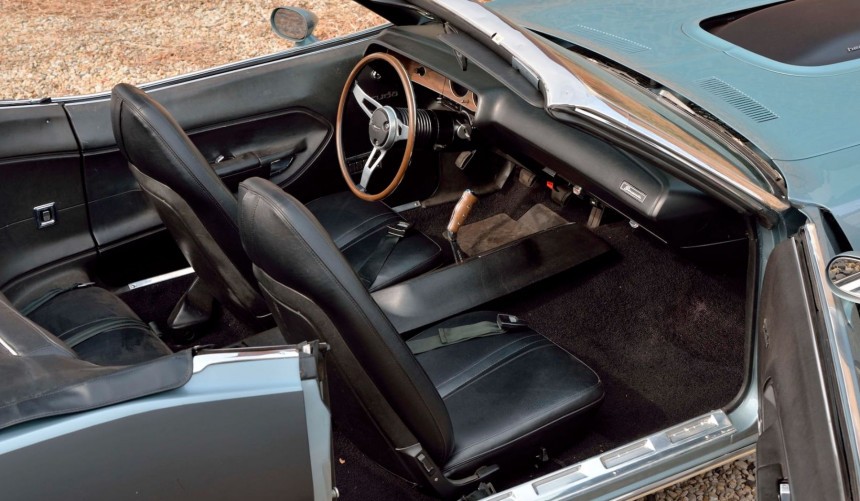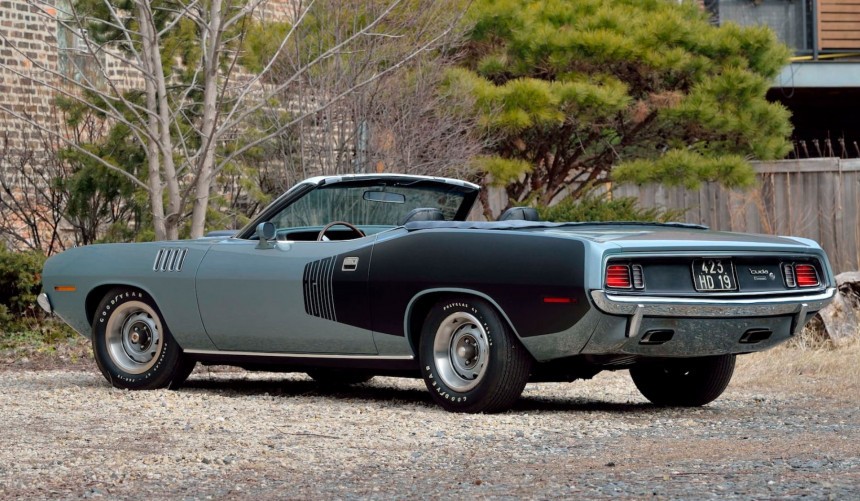From 1970 to 1971, the Plymouth Barracuda was available with Chrysler’s legendary 426 HEMI. Just 780 units left the factory with that monstrous powerplant under the hood and out of those, only 21 were convertibles.
In 1969, John E. Herlitz was tasked to design a completely new Barracuda that would abandon any link to the plebian Valiant that served as the base for the previous two generations. The result was a timeless piece of muscle car art built on a shorter, wider version of Chrysler's existing B platform, called the E-body, which was shared with the more upscale Dodge Challenger.
The new body featured an aggressive sunken grille that incorporated a pair of round headlights, a long, wide hood, a shorter deck, and beautifully contoured quarters that ascended to meet the B-pillars, giving the car its distinctly muscular look.
For the first time in model history, the fastback style was gone, and customers could choose between two-door coupe or convertible bodies.
At the time of its release in 1970, the Barracuda was available in three distinct trims: a base model, a somewhat high-end variant dubbed Grand Coupe, and the performance-oriented ‘Cuda. Mid-model year, Plymouth also introduced a low-end version simply called Coupe, but due to poor sales, it was discontinued a year later.
Engine choices for the Coupe, base model, and Grand Coupe included a couple of Slant-6 units, as well as four different V8s. The sportier ‘Cuda ditched the straight-sixes and could only be had with a V8 under the hood, the most capable of which being the 426-ci (7.0-liter) HEMI, which was conservatively rated at 425 hp.
Nicknamed the Elephant engine, this humongous unit traced its roots to a completely new NASCAR project. It was used in the Plymouth Belvedere racing cars that finished first, second, and third at the Daytona 500 in 1964.
Tamed to comply with emission standards, the street version had a lower compression ratio, more conventional internals or manifolds, and dumped the dry-sump lubrication system for a regular wet sump.
When fitted inside the engine bay of the ‘Cuda, it transformed it into a fearsome straight-line performer. This made the model extremely desirable among speed addicts but also a lot more expensive. One of these thoroughbred muscle cars had a sticker price of around $4,000, nearly two times more than the base model. This meant that only 780 HEMI ‘Cudas were sold from 1970 to 1971 when the engine option was discontinued.
Apart from the coupe, Plymouth also offered a convertible version of the HEMI ‘Cuda. Initially, fitting a high-output V8 inside of a convertible body posed a real challenge since the lack of a roof reduced the rigidity of the chassis. To solve the problem, engineers strengthened the unibody at key points, a process that increased the price even more.
Thus, only 14 HEMI-powered convertibles were sold in 1970, and seven more left dealerships in 1971. People were staying away from this model because of its price tag, but little did they know that its value would reach seven-figure sums in the following decades.
In 1971, one of these ultra-rare ‘Cudas made its way to France, where it was brought by Jean Teyssier, a local muscle car enthusiast.
The only convertible to be finished in Winchester Gray Metallic, it was ordered with exterior features such as a black Shaker-scooped hood, an optional black top, matte black HEMI billboard graphics, body-color side mirrors, and Rallye wheels wrapped in Goodyear Polyglas GT tires.
For the interior, the owner opted for the high-back bucket seats, a Rallye dash, woodgrain center console, trims made from the same material, a three-spoke steering wheel, power windows, and a special Euro-spec speedometer.
The HEMI engine was mated to a four-speed manual (one of two ‘71s with this option), complete with a Hurst pistol grip shifter. All that raw power was transferred to the rear wheels through a Dana 60 Sure Grip differential with a 3.54 final gear ratio.
In addition, the car received the A33 Track Pak, which gave it a 26-inch radiator, seven-blade viscous fan, and a sturdier suspension setup.
Teyssier took great care of his precious ride and only racked up close to 90,000 km (55,923 miles) for the next twenty years. In 1993, he decided to sell it and shortly received a call from an American who ended up buying it. About six years after returning to the U.S., the gray ‘Cuda was sold again to its current owner, Tom Lembeck, who has preserved it in its original state.
Last year, it was put on the auction block at a Mecum event, with the highest bid reaching a whopping $4.8 million. To put it into perspective, that kind of money could get you a Bugatti Chiron or not one, but two low-mileage Ferrari F40s. Despite the eye-watering sum he was offered, the owner refused to sell as he reportedly wanted close to $6 million.
The rare 1970-1971 Plymouth HEMI ‘Cuda convertibles are unquestionably some of the greatest, rarest muscle cars ever built. But are they really worth their current value?
Let us know what you think in the comments section, and make sure to check out the YouTube video below by Lou Costabile, who gets a chance to ride shotgun in the most valuable ‘Cuda convertible of them all.
The new body featured an aggressive sunken grille that incorporated a pair of round headlights, a long, wide hood, a shorter deck, and beautifully contoured quarters that ascended to meet the B-pillars, giving the car its distinctly muscular look.
For the first time in model history, the fastback style was gone, and customers could choose between two-door coupe or convertible bodies.
Engine choices for the Coupe, base model, and Grand Coupe included a couple of Slant-6 units, as well as four different V8s. The sportier ‘Cuda ditched the straight-sixes and could only be had with a V8 under the hood, the most capable of which being the 426-ci (7.0-liter) HEMI, which was conservatively rated at 425 hp.
Nicknamed the Elephant engine, this humongous unit traced its roots to a completely new NASCAR project. It was used in the Plymouth Belvedere racing cars that finished first, second, and third at the Daytona 500 in 1964.
When fitted inside the engine bay of the ‘Cuda, it transformed it into a fearsome straight-line performer. This made the model extremely desirable among speed addicts but also a lot more expensive. One of these thoroughbred muscle cars had a sticker price of around $4,000, nearly two times more than the base model. This meant that only 780 HEMI ‘Cudas were sold from 1970 to 1971 when the engine option was discontinued.
Apart from the coupe, Plymouth also offered a convertible version of the HEMI ‘Cuda. Initially, fitting a high-output V8 inside of a convertible body posed a real challenge since the lack of a roof reduced the rigidity of the chassis. To solve the problem, engineers strengthened the unibody at key points, a process that increased the price even more.
In 1971, one of these ultra-rare ‘Cudas made its way to France, where it was brought by Jean Teyssier, a local muscle car enthusiast.
The only convertible to be finished in Winchester Gray Metallic, it was ordered with exterior features such as a black Shaker-scooped hood, an optional black top, matte black HEMI billboard graphics, body-color side mirrors, and Rallye wheels wrapped in Goodyear Polyglas GT tires.
For the interior, the owner opted for the high-back bucket seats, a Rallye dash, woodgrain center console, trims made from the same material, a three-spoke steering wheel, power windows, and a special Euro-spec speedometer.
In addition, the car received the A33 Track Pak, which gave it a 26-inch radiator, seven-blade viscous fan, and a sturdier suspension setup.
Teyssier took great care of his precious ride and only racked up close to 90,000 km (55,923 miles) for the next twenty years. In 1993, he decided to sell it and shortly received a call from an American who ended up buying it. About six years after returning to the U.S., the gray ‘Cuda was sold again to its current owner, Tom Lembeck, who has preserved it in its original state.
The rare 1970-1971 Plymouth HEMI ‘Cuda convertibles are unquestionably some of the greatest, rarest muscle cars ever built. But are they really worth their current value?
Let us know what you think in the comments section, and make sure to check out the YouTube video below by Lou Costabile, who gets a chance to ride shotgun in the most valuable ‘Cuda convertible of them all.
